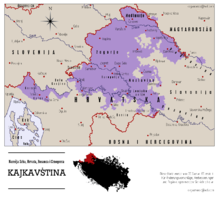Kaykavian
The KAJKAVIAN [ kajkaːʋiʃ ] (Croatian kajkavski, kajkavština ) is a South Slavic dialect group, especially in Croatia is spoken. Like the Čakavische and unlike the Štokavischen the KAJKAVIAN is only there to use and - with the exception of the few Kajkavian varieties of Burgenland, where the Burgenland-Croat completely from the - written language is used Croatian standard language covered . The Kaykavian dialects are spoken in the north of the country; The capital Zagreb is also located in the language area, which gives the dialect a certain prestige.
There is a dialect continuum between Kajkavic and the neighboring Slovene dialects , so that dialects in the area close to the border are often more similar on the other side of the border than on the other side of the border; the state border is only a language border at the standard level. The name Kajkavisch comes from the question word kaj (German was ), which is common in the dialects of this dialect group as well as in Slovenian - in contrast to čakavian ča and štokavian što / šta . The Kaykavian dialects are those of all Croatian dialects that differ most from the standard Štokavian- based language . They are therefore often difficult to understand for speakers who only speak standard language.
Until the 19th century there were parallel efforts to standardize the Kajkavian and Neoštokavian dialects in Croatia. With the Vienna Agreement of 1850, in which Slovene, Croatian and Serbian linguists and politicians agreed on a common - štokavian - dialect base for a standard South Slavic language to be created, the standardization of Kajkavic came to a standstill.
Distinguishing features
Apart from the eponymous question word, Kajkavic differs from the other Croatian and Serbian varieties by a number of characteristic phonological and morphological-syntactic features.
A striking morphosyntactic distinguishing feature is the formation of the future tense in Kajkavic. Instead of the formation with "ću", "ćeš", "će" etc. in connection with the supinum or infinitive , the speakers of Kajkavic use "bum", "buš", "bu" etc. (or "budem", ...) in connection with the past participle active on -l what the Futurbildung in the Slovene corresponds.
- An example of "I'll show you this" :
Kajkavian "Bum ti pokazal" (or "... pokazao" ; Slovenian "Bom ti pokazal" ) instead of standard Croatian "Pokazat ću ti"
In addition, the future tense (instead of the simple present tense ) is used much more frequently in Kajkavic for the near future than in the standard Croatian language.
Language area
The language area of the Kajkavic dialects extends from the Kupa in the southwest to the borders of Slovenia and Hungary in the north. In the east and south, the dialect border between Kajkavian and Štokavian roughly corresponds to the former border between civil Croatia and the former military border and Slavonia . Along this dialect border there are language islands of the other dialect group on both sides . The dialects of the region around Karlovac form transitional dialects to Čakavian , with which they have a short common border in the southwest. With the eastern Slovenian dialects bordering in the northwest, Kajkavic forms a dialect continuum that has only recently begun to dissolve under the influence of the various standard languages .
Traditional urban centers of the Kajkavic area are Zagreb and Varaždin . Especially in Zagreb, however, the use of Kajkavic has recently been suppressed under the influence of the standard language and as a result of immigration from other parts of the country. In rural areas such as the Hrvatsko Zagorje or the Turopolje , however, Kajkavian still prevails today.
The dialects of Gorski kotar on the Croatian-Slovenian border north of Rijeka are often also counted as Kajkavian in overviews of the dialects of Croatian or Serbo-Croatian, as they have some similarities with it, including the question kaj . However, they have no territorial connection to the other Kajkavic dialects and, viewed typologically and genetically, are transitional dialects between Čakavian and Slovenian .
The Croatian population in the two villages of Hidegség and Fertőhomok south of Lake Neusiedl in the Hungarian Győr-Moson-Sopron County also speak Kajkavian. They belong to the group of Burgenland Croats living in Hungary .
Language examples
- Question word what?
- kajkavisch kaj?
- standard language Što?
-
What should I do?
- kajkavic: Kaj bi trebal napraviti?
- standard language Što bih trebao napraviti?
-
Don't be stupid, donkey.
- kajkavian Naj biti bedast, osel everyone.
- standard language Nemoj biti glup, magarče jedan.
-
I ate bread beforehand.
- kajkavisch Jel sam malo predi falačec kruha.
- standard language Jeo sam malo prije komad kruha.
-
That will not work / work. (It doesn't work like that.)
- kajkavian Ne bu (to) išlo.
- standard language Ne može tako.
-
The best example from the Turopolje region : "Something's going to happen today ..."
- kajkavian: Jel bu kaj?
- standard language Hoće li biti što?
- Kaj buš ti, bum i yes! (What you do, I do that too!)
Web links
- Mijo Lončarić: Kajkawisch (PDF; 247 kB) - from: Encyclopedia of the European East (241 kB)
- Poems from Međimurje ( Memento of March 10, 2008 in the Internet Archive ) in the Internet Archive
- Small dictionary Međimurje ( memento from February 29, 2008 in the Internet Archive ) in the Internet Archive
Individual evidence
- ↑ cf. Radoslav Katičić: Croatian. In: Uwe Hinrichs (Hrsg.): Handbuch der Südosteuropa-Linguistik. Harrassowitz, Wiesbaden 1999, pp. 383-412

